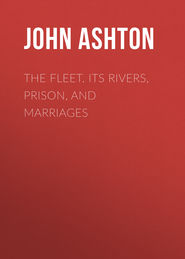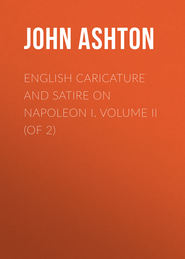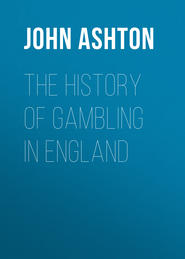По всем вопросам обращайтесь на: info@litportal.ru
(©) 2003-2024.
✖
Eighteenth Century Waifs
Настройки чтения
Размер шрифта
Высота строк
Поля
‘Il Convito Amoroso,
Or a Serio – comico – philosophical
Lecture
on the
Causes, Nature, and Effects of Love and Beauty,
At the Different Periods of Human Life, in Persons, and
Personages, Male, Female, and Demi-Charactêre;
And in Praise of the Genial and Prolific Influences of the
Celestial Bed!
As Delivered by Hebe Vestina,
The Rosy Goddess of Youth and of Health!
from the
Electrical Throne! in the Great Apollo-Chamber,
At the Temple of Hymen, in London,
Before a glowing and brilliant Audience of near Three Hundred Ladies and Gentlemen, who were commanded by Venus, Cupid, and Hymen! to assist, in joyous Assembly, at the Grand Feast of very Fat Things, which was held at their Temple, on Monday Evening, the 25th of November, 1782; but which was interrupted by the rude and unexpected Arrival of his Worship Midas Neutersex, Esqre. … just as the Dessert was about to be served up.
Published at the earnest Desire of many of the Company, and to gratify the impatient and very intense longings of Thousands of Adepts, Hibernian and British; – of the Cognoscenti; – et de les Amateur ardens des delices exquise de Venus!
To which is subjoined, a description of the Stupendous Nature and Effects of the Celebrated
Celestial Bed!’
The ‘Vestina, or Goddess of Health,’ was no mean person. She began life as a domestic servant, and was named Emma Lyons. She was a good-looking, florid, buxom wench, and, after having played her part as priestess at the ‘Temple of Health and Hymen,’ became the wife of the dilletante Sir William Hamilton, English Minister at Naples, and was afterwards notorious for her connection with Lord Nelson.
Graham wrote in 1790, ‘A short Treatise on the All cleansing – all healing – and all invigorating Qualities of the Simple Earth, when long and repeatedly applied to the naked Human Body and Lungs, for the safe, speedy, and radical Cure of all Diseases, internal as well as external, which are, in their Nature or Stage, susceptible of being cured; – for the preservation of the Health, Vigour, Bloom, and Beauty of Body and of Mind; for rejuvenating the aged and decaying Human Body; – and for prolonging Life to the very longest possible Period, &c.’
For the benefit of those who would try the doctor’s earth-cure, I extract the following: ‘I generally, or always, prefer the sides or tops of hills or mountains, as the air and the earth are the more pure and salubrious; but the air and earth of ordinary pasture or corn-fields, especially those that are called upland, and even good clean garden-ground, or the higher commons, especially fallow corn-fields, are all salutary and good.
‘As to the colour and nature of the earth or soil, I prefer a good brown or reddish blooming mould, and light, sandy, crumbly, mellow and marrowy earth; or that which feels when I am in it, and crumbling with my hands and fingers, like bits of marrow among fine Flour; and that which has a strong, sweet, earthly smell – ’
So that my readers now know exactly what to do.
He had a fairly comprehensive idea of modern hygiene, as will be seen from the following extract from ‘General Instructions to the persons who consult Dr. Graham as a Physician’:
‘It will be unreasonable for Dr. Graham’s Patients to expect a complete and a lasting cure, or even great alleviation of their peculiar maladies, unless they keep the body and limbs most perfectly clean with very frequent washings, – breathe fresh, open air day and night, – be simple in the quality and moderate in the quantity of their food and drink, – and totally give up using the deadly poisons and weakeners of both body and soul, and the cankerworm of estates called foreign Tea and Coffee, Red Port Wine, Spirituous Liquors, Tobacco and Snuff, gaming and late hours, and all sinful, unnatural, and excessive indulgence of the animal appetites, and of the diabolical and degrading mental passions. On practising the above rules – on a widely open window day and night – and on washing with cold water, and going to bed every night by eight or nine, and rising by four or five, depends the very perfection of bodily and mental health, strength and happiness.’
He wrote many pamphlets, some of them on religious matters, and the fools who patronised him paid him large fees; yet his expenses were very heavy, and his manner of living luxurious, so that we experience but little wonder when we find the ‘Temple of Health’ sold up, and that Graham himself died poor – either in, or near, Glasgow.
Early in the century there were (in surgery) two noted quacks, namely, Dr. (afterwards Sir William) Read, and Roger, or, as he called himself, Doctor, Grant – both oculists. Read originally was a tailor, and Grant had been a tinker and Anabaptist preacher. The list of cures of both are marvellous – Grant even advertising in the Daily Courant, of July 20, 1709, that he had cured, in five minutes, a young man that had been born blind. But at that time, when people believed in their sovereign being able to cure scrofula by touching the patient with a gold coin, a little faith went a long way.
But quackery was not confined to the masculine gender – the ladies competed with them in the field. Notably Mrs. Map, the bone-setter of Epsom, of whom Mr. Pulteney writes so amusingly to Swift on December 21, 1736: ‘I must tell you a ridiculous incident; perhaps you have not heard it. One Mrs. Mapp, a famous she bone-setter and mountebank, coming to town with a coach and six horses, on the Kentish road, was met by a rabble of people, who, seeing her very oddly and tawdrily dressed, took her for a foreigner, and concluded she must be a certain great person’s mistress. Upon this they followed the coach, bawling out, “No Hanover w – ! No Hanover w – !” The lady within the coach was much offended, let down the glass, and screamed louder than any of them, “She was no Hanover w – ! she was an English one!” Upon which they cried out, “God bless your ladyship!” quitted the pursuit, and wished her a good journey.’
This woman sprang into notoriety all at once. The first authentic account of her is on page 457 of the London Magazine for 1836, under the date of August 2: ‘The Town has been surprized lately with the fame of a young woman at Epsom, who, tho’ not very regular, it is said, in her Conduct, has wrought such Cures that seem miraculous in the Bone-setting way. The Concourse of People to Epsom on this occasion is incredible, and ’tis reckon’d she gets near 20 Guineas a Day, she executing what she does in a very quick Manner: She has strength enough to put in any Man’s Shoulder without any assistance; and this her strength makes the following Story the more credible. A Man came to her, sent, as ’tis supposed, by some Surgeons, on purpose to try her Skill, with his Hand bound up, and pretended his Wrist was put out, which upon Examination she found to be false; but, to be even with him for his Imposition, she gave it a Wrench, and really put it out, and bad him go to the Fools who sent him, and get it set again, or, if he would come to her that day month, she would do it herself.
‘This remarkable person is Daughter to one Wallin, a Bone-setter of Hindon, Wilts. Upon some family Quarrel, she left her Father, and Wander’d up and down the Country in a very miserable Manner, calling herself Crazy Salley. Since she became thus famous, she married one Mr. Hill Mapp, late servant to a Mercer on Ludgate Hill, who, ’tis said, soon left her, and carried off £100 of her Money.’
She was not long making her way in the world, for we read in the same magazine, under date, September 19, 1736: ‘Mrs. Mapp, the famous Bone-setter at Epsom, continues making extraordinary Cures. She has now set up an Equipage, and this Day came to Kensington and waited on her Majesty.’
The Gentleman’s Magazine, under date of August 31, 1736, gives a similar account of her private life, adding that her husband did not stay with her above a fortnight, but adds that she was wonderfully clever in her calling, having ‘cured Persons who have been above 20 years disabled, and has given incredible Relief in most difficult cases.’
‘Mrs. Mapp the Bone-setter, with Dr. Taylor the Oculist, being present at the Playhouse in Lincoln’s Inns Fields, to see a Comedy call’d the Husband’s Relief, with the Female Bone-setter, and Worm Doctor; it occasioned a full House, and the following
Epigram
‘While Mapp to th’ Actors shew’d a kind regard,
On one side Taylor sat, on t’other Ward:
When their mock Persons of the Drama came,
Both Ward and Taylor thought it hurt their fame;
Wonder’d how Mapp cou’d in good Humour be —
Zoons, crys the Manly Dame, it hurts not me;
Quacks without Arts may either blind or kill,
But Demonstration shews that mine is Skill.
And the following was sung upon ye Stage:
You Surgeons of London who puzzle your Pates,
To ride in your Coaches, and purchase Estates,
Give over, for Shame, for your Pride has a Fall,
And ye Doctress of Epsom has outdone you all.
What signifies Learning, or going to school,
When a Woman can do without Reason or Rule,
What puts you to Non-plus, and baffles your Art,
For Petticoat-Practice has now got the Start.
In Physick, as well as in Fashions, we find
The newest has always its Run with Mankind;
Forgot is the bustle ‘bout Taylor and Ward,
Now Mapp’s all ye Cry, and her Fame’s on Record.
Dame Nature has giv’n her a Doctor’s Degree,
She gets all ye Patients, and pockets the Fee;
So if you don’t instantly prove her a Cheat,
She’ll loll in her Chariot while you walk ye Street.’[105 - Gentleman’s Magazine, 1736, pp. 617-618.]
At this time she was at her acme – but if an anonymous writer in the Cornhill Magazine for March, 1873, p. 82, is to be believed, she died December, 1837, ‘at her lodgings near Seven Dials, so miserably poor, that the parish was obliged to bury her.’
Or a Serio – comico – philosophical
Lecture
on the
Causes, Nature, and Effects of Love and Beauty,
At the Different Periods of Human Life, in Persons, and
Personages, Male, Female, and Demi-Charactêre;
And in Praise of the Genial and Prolific Influences of the
Celestial Bed!
As Delivered by Hebe Vestina,
The Rosy Goddess of Youth and of Health!
from the
Electrical Throne! in the Great Apollo-Chamber,
At the Temple of Hymen, in London,
Before a glowing and brilliant Audience of near Three Hundred Ladies and Gentlemen, who were commanded by Venus, Cupid, and Hymen! to assist, in joyous Assembly, at the Grand Feast of very Fat Things, which was held at their Temple, on Monday Evening, the 25th of November, 1782; but which was interrupted by the rude and unexpected Arrival of his Worship Midas Neutersex, Esqre. … just as the Dessert was about to be served up.
Published at the earnest Desire of many of the Company, and to gratify the impatient and very intense longings of Thousands of Adepts, Hibernian and British; – of the Cognoscenti; – et de les Amateur ardens des delices exquise de Venus!
To which is subjoined, a description of the Stupendous Nature and Effects of the Celebrated
Celestial Bed!’
The ‘Vestina, or Goddess of Health,’ was no mean person. She began life as a domestic servant, and was named Emma Lyons. She was a good-looking, florid, buxom wench, and, after having played her part as priestess at the ‘Temple of Health and Hymen,’ became the wife of the dilletante Sir William Hamilton, English Minister at Naples, and was afterwards notorious for her connection with Lord Nelson.
Graham wrote in 1790, ‘A short Treatise on the All cleansing – all healing – and all invigorating Qualities of the Simple Earth, when long and repeatedly applied to the naked Human Body and Lungs, for the safe, speedy, and radical Cure of all Diseases, internal as well as external, which are, in their Nature or Stage, susceptible of being cured; – for the preservation of the Health, Vigour, Bloom, and Beauty of Body and of Mind; for rejuvenating the aged and decaying Human Body; – and for prolonging Life to the very longest possible Period, &c.’
For the benefit of those who would try the doctor’s earth-cure, I extract the following: ‘I generally, or always, prefer the sides or tops of hills or mountains, as the air and the earth are the more pure and salubrious; but the air and earth of ordinary pasture or corn-fields, especially those that are called upland, and even good clean garden-ground, or the higher commons, especially fallow corn-fields, are all salutary and good.
‘As to the colour and nature of the earth or soil, I prefer a good brown or reddish blooming mould, and light, sandy, crumbly, mellow and marrowy earth; or that which feels when I am in it, and crumbling with my hands and fingers, like bits of marrow among fine Flour; and that which has a strong, sweet, earthly smell – ’
So that my readers now know exactly what to do.
He had a fairly comprehensive idea of modern hygiene, as will be seen from the following extract from ‘General Instructions to the persons who consult Dr. Graham as a Physician’:
‘It will be unreasonable for Dr. Graham’s Patients to expect a complete and a lasting cure, or even great alleviation of their peculiar maladies, unless they keep the body and limbs most perfectly clean with very frequent washings, – breathe fresh, open air day and night, – be simple in the quality and moderate in the quantity of their food and drink, – and totally give up using the deadly poisons and weakeners of both body and soul, and the cankerworm of estates called foreign Tea and Coffee, Red Port Wine, Spirituous Liquors, Tobacco and Snuff, gaming and late hours, and all sinful, unnatural, and excessive indulgence of the animal appetites, and of the diabolical and degrading mental passions. On practising the above rules – on a widely open window day and night – and on washing with cold water, and going to bed every night by eight or nine, and rising by four or five, depends the very perfection of bodily and mental health, strength and happiness.’
He wrote many pamphlets, some of them on religious matters, and the fools who patronised him paid him large fees; yet his expenses were very heavy, and his manner of living luxurious, so that we experience but little wonder when we find the ‘Temple of Health’ sold up, and that Graham himself died poor – either in, or near, Glasgow.
Early in the century there were (in surgery) two noted quacks, namely, Dr. (afterwards Sir William) Read, and Roger, or, as he called himself, Doctor, Grant – both oculists. Read originally was a tailor, and Grant had been a tinker and Anabaptist preacher. The list of cures of both are marvellous – Grant even advertising in the Daily Courant, of July 20, 1709, that he had cured, in five minutes, a young man that had been born blind. But at that time, when people believed in their sovereign being able to cure scrofula by touching the patient with a gold coin, a little faith went a long way.
But quackery was not confined to the masculine gender – the ladies competed with them in the field. Notably Mrs. Map, the bone-setter of Epsom, of whom Mr. Pulteney writes so amusingly to Swift on December 21, 1736: ‘I must tell you a ridiculous incident; perhaps you have not heard it. One Mrs. Mapp, a famous she bone-setter and mountebank, coming to town with a coach and six horses, on the Kentish road, was met by a rabble of people, who, seeing her very oddly and tawdrily dressed, took her for a foreigner, and concluded she must be a certain great person’s mistress. Upon this they followed the coach, bawling out, “No Hanover w – ! No Hanover w – !” The lady within the coach was much offended, let down the glass, and screamed louder than any of them, “She was no Hanover w – ! she was an English one!” Upon which they cried out, “God bless your ladyship!” quitted the pursuit, and wished her a good journey.’
This woman sprang into notoriety all at once. The first authentic account of her is on page 457 of the London Magazine for 1836, under the date of August 2: ‘The Town has been surprized lately with the fame of a young woman at Epsom, who, tho’ not very regular, it is said, in her Conduct, has wrought such Cures that seem miraculous in the Bone-setting way. The Concourse of People to Epsom on this occasion is incredible, and ’tis reckon’d she gets near 20 Guineas a Day, she executing what she does in a very quick Manner: She has strength enough to put in any Man’s Shoulder without any assistance; and this her strength makes the following Story the more credible. A Man came to her, sent, as ’tis supposed, by some Surgeons, on purpose to try her Skill, with his Hand bound up, and pretended his Wrist was put out, which upon Examination she found to be false; but, to be even with him for his Imposition, she gave it a Wrench, and really put it out, and bad him go to the Fools who sent him, and get it set again, or, if he would come to her that day month, she would do it herself.
‘This remarkable person is Daughter to one Wallin, a Bone-setter of Hindon, Wilts. Upon some family Quarrel, she left her Father, and Wander’d up and down the Country in a very miserable Manner, calling herself Crazy Salley. Since she became thus famous, she married one Mr. Hill Mapp, late servant to a Mercer on Ludgate Hill, who, ’tis said, soon left her, and carried off £100 of her Money.’
She was not long making her way in the world, for we read in the same magazine, under date, September 19, 1736: ‘Mrs. Mapp, the famous Bone-setter at Epsom, continues making extraordinary Cures. She has now set up an Equipage, and this Day came to Kensington and waited on her Majesty.’
The Gentleman’s Magazine, under date of August 31, 1736, gives a similar account of her private life, adding that her husband did not stay with her above a fortnight, but adds that she was wonderfully clever in her calling, having ‘cured Persons who have been above 20 years disabled, and has given incredible Relief in most difficult cases.’
‘Mrs. Mapp the Bone-setter, with Dr. Taylor the Oculist, being present at the Playhouse in Lincoln’s Inns Fields, to see a Comedy call’d the Husband’s Relief, with the Female Bone-setter, and Worm Doctor; it occasioned a full House, and the following
Epigram
‘While Mapp to th’ Actors shew’d a kind regard,
On one side Taylor sat, on t’other Ward:
When their mock Persons of the Drama came,
Both Ward and Taylor thought it hurt their fame;
Wonder’d how Mapp cou’d in good Humour be —
Zoons, crys the Manly Dame, it hurts not me;
Quacks without Arts may either blind or kill,
But Demonstration shews that mine is Skill.
And the following was sung upon ye Stage:
You Surgeons of London who puzzle your Pates,
To ride in your Coaches, and purchase Estates,
Give over, for Shame, for your Pride has a Fall,
And ye Doctress of Epsom has outdone you all.
What signifies Learning, or going to school,
When a Woman can do without Reason or Rule,
What puts you to Non-plus, and baffles your Art,
For Petticoat-Practice has now got the Start.
In Physick, as well as in Fashions, we find
The newest has always its Run with Mankind;
Forgot is the bustle ‘bout Taylor and Ward,
Now Mapp’s all ye Cry, and her Fame’s on Record.
Dame Nature has giv’n her a Doctor’s Degree,
She gets all ye Patients, and pockets the Fee;
So if you don’t instantly prove her a Cheat,
She’ll loll in her Chariot while you walk ye Street.’[105 - Gentleman’s Magazine, 1736, pp. 617-618.]
At this time she was at her acme – but if an anonymous writer in the Cornhill Magazine for March, 1873, p. 82, is to be believed, she died December, 1837, ‘at her lodgings near Seven Dials, so miserably poor, that the parish was obliged to bury her.’











